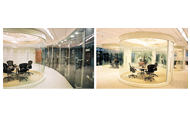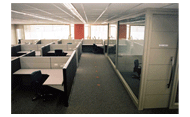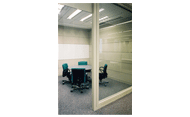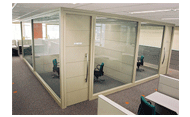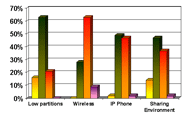Wireless, IP telephony, and innovative office design greatly lower real estate costs and boost employee productivity.
The Cisco São Paulo office has grown very rapidly, from less than 20 people in 1997 to 132 people today. Because of this expansion, the Cisco Workplace Resources group struggled with options for housing its employees. In 1999, there were limited nearby real estate vacancies into which the office could expand. It became clear that the traditional office environment was not flexible enough for the demands of the burgeoning São Paulo office. New workplace solutions needed to be implemented to improve flexibility and mobility, supported by leading-edge technology.
Fortunately, the site leaders strongly supported the implementation of innovative workplace solutions to address the changing needs of the office. They didn't believe that people should be bound to their cubicles or offices. In fact, account managers were encouraged to spend little time in the office, instead devoting the majority of their time to their customers, at customer sites.
Several technology solutions were implemented that enabled the workplace environment in the Cisco São Paulo office to change significantly. To begin this change, everyone in the office was provided with a cell phone and high-speed Internet access to their homes. This gave them the freedom to easily work from home with remote access. Using the Cisco Secure VPN Client software on their laptop computers, they were able to access corporate applications as quickly and as securely as if they were in the office.
The physical office also changed. First, the cubicle sizes were reduced and partitions between the cubicles were lowered. This transformed the office from an area of individual workspaces to one in which everyone knew when and where their team members were available. Collaboration occurred more easily in this new design.
People began sharing cubicles and reducing their personal storage to just one small rolling file cabinet per person. To encourage adoption of this new workplace, managers gave up their assigned offices and today share their offices at a 2:1 ratio. Almost all the offices have round tables (difficult to work at individually for a long time) that are unassigned. When a manager is not occupying an office, employees may use it as a conference room.
As the network became even more robust, the office became paperless, eliminating the need for almost all the file cabinets. The implementation of IP telephony in the office in 2002 made sharing workspaces even simpler because it allowed employees to easily program the phones to receive their personal extensions in any work area they selected, using the Extension Mobility feature of Cisco Call Manager. They also can use Cisco Personal Assistant software to direct callers to their cell or home numbers; and Cisco Conference Connection software to schedule conferences or conduct conferences immediately with colleagues working from home or other locations.
Using Cisco wireless LAN technology increased employees’ freedom to access the corporate network from any location within the office, including the shared tables and conference rooms, turning any space in the office into a productive work area. The use of Cisco Aironet® products and Cisco IP Softphone on laptop computers also removed the need to provide costly additional cabling to the shared tables and conference rooms, and enabled the Cisco Workplace Resources group to rearrange shared spaces without having to move cabling.
The Cisco São Paulo office has moved from a traditional environment with assigned offices and cubicles to one that is almost completely virtual. Using internet solutions, Cisco was able to significantly reduce the space needs in the office, avoiding $1.2 million in profit and loss expenses and $1M in expenditures (cash flow) over 3 years. This means that annual cost per employee for the office was reduced 30 percent from $8483/employee /year to $5671/employee /year.
At the same time, productivity has increased in the office. A survey showed that employees in the SÃo Paulo office believed that their productivity has improved an average of 9% in the new work environment (more survey results shown below). It has become easier to find space for customer meetings or team collaboration because offices can be used as meeting rooms. The office design enabled many unplanned interactions, which reduced the number of formal meetings that were necessary. Also, because of the mobility encouraged by the physical and technological environment and the site management, employees can work at home during peak traffic hours, saving up to 4 hours a week in the car per employee.
Though skeptical at first about losing their individual workspaces, employees now agree that the environment improves their effectiveness in the office. Sixty-nine percent of Cisco employees in SÃo Paulo say that the new sharing environment with low partitions improves their productivity, while indicating that the wireless network and IP phones were significant enablers of this new more productive atmosphere.
The Cisco Workplace Resources group is evaluating the Sao Paulo office model for deployment in other locations worldwide.
